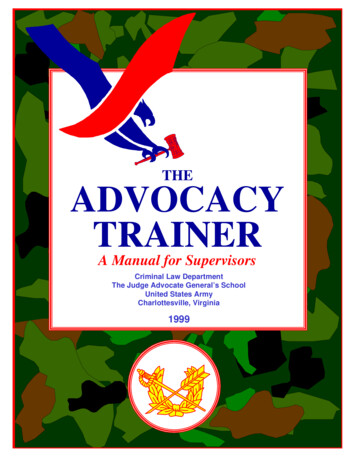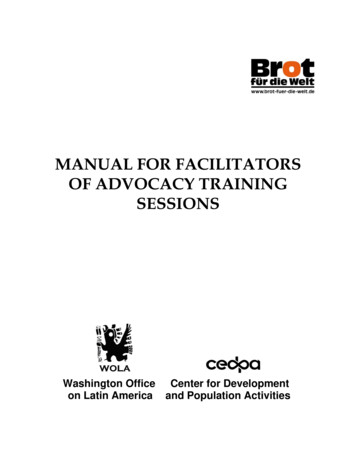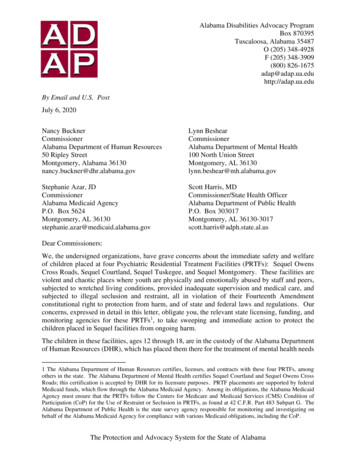
Transcription
THEADVOCACYTRAINERA Manual for SupervisorsCriminal Law DepartmentThe Judge Advocate General’s SchoolUnited States ArmyCharlottesville, Virginia1999
THE ADVOCACY TRAINERA Manual for SupervisorsTABLE OF CONTENTSFOREWORDTAB AINTRODUCTIONTAB BLEARN THE SKILLModule 1:Module 2:TAB CDirect Examination - The Fundamentals Form of the QuestionAPPLY THE SKILLModule 1:Module 2:Module 3:Module 3a:Module 4:Voir DireOpening StatementsClosing ArgumentsRebuttal ArgumentsExamination of Lay Witnesses - Direct and Cross Module 5:Module 6:Module 7:TAB DForm of the Question, Inflection, Body LanguageCross Examination - The FundamentalsAssault VictimPX RepresentativeExpert Witnesses Qualifying the Witness: Drug ExpertAssembly of Sentencing CaseSentencing Proceedings Company Commander - Direct ExaminationModule 8:Objections - The FundamentalsModule 9:Module 10:DemonstrationsSentencing ProceedingsModule 11:Motion Practice Article 10, UCMJ Motion to suppress evidence VideotapeThe Accused - Direct ExaminationDEVELOP THE SKILL: IMPEACHMENTModule 1:Module 2:Module 3:Module 4:Module 5:Bias, Prejudice and MotivePrior Untruthful ActsPrior ConvictionPrior Inconsistent StatementsVisual Observation2000 by Criminal Law Department,The Judge Advocate General’s School
TAB EDEVELOP THE SKILL: FOUNDATIONSModule 1:Module 2:Module 3:Module 4:Module 5:Module 6:Module 7:Module 8:Module 9:Module 10:Module 11:Module 12:Module 13:Module 14:Module 15:Module 16:TAB FDiagramsRefreshing Memory and Past Recollection RecordedBad ChecksBusiness and Military RecordsPhotographsHabit EvidenceVoice IdentificationsIdentification of the AccusedConfessionsBAC TestsVideotapesX-raysFax and E-mail DocumentsFingerprintsReputation/Opinion EvidenceFungible and Non-Fungible EvidenceHEARSAYModule 1:Module 2:Module 3:Module 4:Present Sense ImpressionExcited UtteranceStatements for Purposes of Medical Diagnosis or TreatmentResidual Hearsay2000 by Criminal Law Department,The Judge Advocate General’s School
NOTE TO THE TRAINERNothing beats the concentration of preparing for and trying a case. There are,however, many ways to get ready to try those cases better. The materials in THEADVOCACY TRAINER make it easier for you to train your counsel. They enable you toidentify a skill on which you want to train counsel, select the module, follow thepreparation instructions, and conduct the training.Before your first session, read the Introduction, which suggests several methodsfor conducting the training. Then pick a module, set a date, and do some training!THE ADVOCACY TRAINER provides a, not the exclusive method of trainingcounsel. Although nothing takes the place of rehearsing counsel before trial, this bookenables you to train counsel beyond the issues that arise in particular cases. Innovatewhile using THE ADVOCACY TRAINER. For example, while counsel can be used to playwitness roles, consider inviting other participants, especially other professionals (lawenforcement and medical personnel) who are likely to testify in court themselves; this canmake your training more realistic and give these participants valuable courtroompreparation. In addition, you should treat each record of trial as a potential trainingpackage: review, tab, and copy portions that can be used to create situational trainingexercises.Use the scenarios in this book as they are written, or adapt them to the needs ofyour counsel. The materials are sufficiently flexible that you can adjust the demands,duration, and intensity of the training. And you can use them over and over. Themodules can also be used to sustain the skills of more experienced counsel, as all counselcan always get sharper. In addition, of course, the participation of experienced counselsets an example on two important levels: (1) how to perform better in court, and (2) thevalue of training to the already proficient.THE ADVOCACY TRAINER represents the combined efforts of many judgeadvocates, not only the TJAGSA Criminal Law Department, its primary authors andeditors, but also senior judge advocates and several members of the 45th Graduate Course.It is not a static package. Let us know what works and what doesn’t. Also, let us knowyour needs. With your input, future supplements will be geared to the training needs ofyou and your counsel. Send your suggestions to Chief, Criminal Law Department, TheJudge Advocate General’s School, ATTN: THE ADVOCACY TRAINER, 600 Massie Road,Charlottesville, Virginia 22903. Phone: (804) 972-6340. Electronic mail:advtrngm@otjag.army.mil1999 by Criminal Law Department,The Judge Advocate General’s School
AuthorsLTC Lawrence J. MorrisLTC James K. LovejoyLTC Stephen HenleyMAJ Charles N. PedeMAJ Norman F.J. Allen IIIMAJ Gregory B. CoeMAJ John P. EinwechterMAJ Edye U. MoranMaj Martin H. Sitler, USMCMAJ Victor M. HansenMAJ Michael J. HargisMAJ Walter M. HudsonCPT Erik Christiansen45th Graduate Course ContributorsLCDR Brenda Armstrong, USNMAJ Bryan BroylesMAJ Geoffrey CornMAJ Michael KleinMAJ Kurt MiethLCDR Thomas Miro, USNMAJ John Saunders46th Graduate Course ContributorsLtCol Kenneth Martin, USMCLtCol Robert Sokoloski, USMCLCDR Lara Jowers, USNMAJ Michael Henry47th Graduate Course ContributorsMAJ Michael SeidelMajor Gary Barthel, USMCMajor Robert Miller, USMCMajor John Schum, USMCLCDR Andrea Prince, USNProductionMrs. Ellen C. BeauchampMr. Dennis MillsMr. Byrd EasthamMr. James DaveyContributing EditorsLTC Donald G. Curry, Jr.LTC Patrick LisowskiCOL Denise VowellCOL Fredric I. Lederer1999 by Criminal Law Department,The Judge Advocate General’s School
THE ADVOCACY TRAINERA Manual for SupervisorsINTRODUCTIONThe flowers of advocacy are hothouse plantsWinston ChurchillI.CONCEPT.A.These materials provide supervisors of trial and defense counsel with an informaland entertaining means of training subordinates and assessing their fundamentaltrial advocacy skills. In the spirit of “hip pocket training,” this book providesChiefs of Justice and Senior Defense Counsel with a tool to enhance trainingconducted on a short or no-notice basis. The objective of this training is tomaximize time spent practicing the skills necessary for effective advocacy, and tominimize the time counsel spend role playing or memorizing hypothetical factpatterns.B.Additionally, by providing supervisors with necessary materials, the manualenables supervisors to devote their energies to teaching counsel and assessingsubordinates’ performances, rather than developing advocacy training fromscratch.II.STRUCTURE.A.The Training Module. The training module for each advocacy skill is generallythe same. Each module contains the following:1.Supervisor’s Guide. This guide provides an overview of the advocacyskill and provides specific instructions for conducting the advocacy skilldrills.A-1
B.III.2.Counsel Handout. Each training module contains a Counsel Handoutthat you should photocopy and distribute prior to each training session.The handout includes: a brief introduction that explains the purpose of thetraining, instructions for any necessary preparation by counsel, the keys tosuccess for the advocacy skill highlighted, and a reference list forcounsel’s independent study.3.Evidence. Each training module contains the Evidence (if needed) forcounsel use during the training. Items such as sworn statements orphysical evidence (checks or other business records) are included ifrequired by the skill drill.4.Sample Solution. Each training module contains Sample Solutions thatyou can use in conjunction with the critique that you conduct after eachtraining session.Your Training Plan. The training modules may be used in two ways.1.Training Plan 1: Start with TAB B, Module 1, and each week, every twoweeks, or every month, train with the next tab in order. You need onlyprovide the TIME and LOCATION. Time required: Flexible. Many drillscan be done effectively in 15 minutes. The same drills can be enhanced ina one hour training session. The key is setting the time aside.2.Training Plan 2: Given counsel weaknesses and your personalpreferences, simply choose a module from anywhere in the text andconduct training. Ideally, the skills build on one another. One module isnot, however, a prerequisite for another. The sequence of your training isa function of your priorities and identified strengths and weaknesses.RESOURCES.A.All materials necessary to conduct training are included. You must onlyreproduce sufficient copies of the Counsel Handout and Evidence for yoursubordinates. Counsel should always bring their Manual for Courts-Martial,Benchbook, and an evidentiary foundations text to the training. A television andVCR are needed when videotapes are part of the training materials.A-2
B.Although supervisors are encouraged to incorporate other materials relevant to thetraining, this is not required for successful training. To the extent possible, yoursubordinates should only be the examining counsel. You, or one of your legalspecialists, should play the roles of witness or judge. The most importantresource you will need is your most precious resource, time.IV.BUT I DON’T KNOW HOW TO TRAIN!A.Most judge advocates question whether they’re qualified to train, and even ifqualified, are uncertain how to do it well. The critique methodology providedbelow (based on the National Institute of Trial Advocacy model) is a completerecipe for providing excellent training and critiques to your counsel. And it getseasier and better the more you do it!B.Construct and deliver your critiques using the following model. HEADNOTE. Tell them WHAT the skill is you are going to address and WHYit is important. Not just, “should lead on cross,” but “we are going to discussleading on cross-examination. It is important because it keeps you in controlof the exam and keeps the witness from straying into material that is notcentral to your theory of the case.”PLAY BACK the advocate’s words. You need not keep a verbatim log (yourattention should remain on the speaker when performing) but you should beable to quote, as accurately as possible, the speaker’s words. This reinforcesthat you do not have just a vague point – “you didn’t lead much” – but thatyou can point to exact language that was ineffectual or objectionable. Whenyou can quote the speaker’s language, that person is much less likely to bedefensive, will realize the close attention you paid to the performance, andwill be more likely to heed your advice.PRESCRIPTION. What to do next time. Avoid “what I would have done”language, as any resentful lawyer is likely to tell you to go ahead and do it(which you will do shortly). Tell them, however, what approach you suggestfor next time. “Instead of repeating ‘the evidence will show’ in your openingstatement, say it once early, then stick to telling the story, as this will avoid anobjection while also enabling you to keep the tightest grip on the panel’sattention as you paint a word picture.”A-3
MODEL AND RATIONALE. This is where you earn your pay. After criticizingthe advocate, show how it should be done. This need not be theatrical orelaborate (though it can be both in the right circumstances), but only has to bea solid example of how to perform the criticized portion of the case correctly.This has two main purposes: (a) the student will remember your showing himhow to perform much more than a fairly abstract critique of what he didwrong, and (b) it cements your credibility as instructor, if you can help thestudent navigate through a better way of performing the criticized task.C.This methodology is not meant to be complicated or confining. It is meant to giveyou a logical construct for helping another lawyer perform better. Following thisgeneral structure will help you think harder about which points to critique, whythey are important, and what specific advice you can give about how to performnext time.D.Time. When conducting the drills, have a plan for when to critiqueand how long the critique will be. Of course a host of variables, including howlong you have to train and the number of counsel, affect this. Letting counselperform most or all of the drill, makes the drill as close to real life as possible: incourt, counsel get no reinforcement until after trial when a verdict is delivered orsupervisors and judges conduct critiques. On the other hand, the value of a drill isthat it is not real life and you can stop performance – especially performance thatis well off the mark – and have counsel start over, or perform an aspect of theevaluated skill again. If counsel are routinely stopped too frequently, thedisadvantage is that they might become intimidated (afraid to take a risk becauseof impending interruption) or complacent (relying on the supervisor to insertfrequent mid-course corrections, thereby sweating insufficiently to get anyconditioning value from the drill). Waiting until after the drill makes it most likereal life, but may leave you with too many points to make and diminish theabsorption value for counsel.E.Videotape. Consider using videotapes in your training. You need not do this allof the time (need to build in time to set up machines, review the tapes), but tapinghas several virtues: CREDIBILITY. Even when you use the “playback” method of quotingcounsel’s words back to them, nothing is as effective as seeing and hearingthose words uttered. Your credibility is stronger when your critique isvalidated by counsel’s seeing and hearing what you just told them they said.A-4
F.SELF-DIAGNOSIS. Give your counsel the credit they have earned as attorneys.Much of the time they will recognize their errors upon viewing them.PRIVATE REVIEW. Counsel can take the tapes home or to their offices toreview privately (reinforces the self-diagnosis). Also, you can review them 1on-1 with counsel, sparing them possible embarrassment, especially on stylematters, in front of peers.TIME CRUNCHES. If you have a short time in which to conduct training, youdo not have to sacrifice drill time if you tape the exercises for later (but closein time) review.Typical Critique Points. V.STYLE. Your critiques generally should focus on substance as opposed to thepeculiar but often minor stylistic quirks all of us have. It is often a “cheap” oreasy critique to focus on a distracting mannerism (hands in the pockets, toomany “ums”) instead of the more difficult and substantive legal critiques(failure to lead, disorganized argument, and here’s how to fix it).Occasionally, however, you should ensure that counsel receive critiques ontheir style – pace and cadence of speech, mannerisms and the like.Videotapes help you accomplish this, and enable you to focus most of yourcritiques on substance.Form of the questionLength of the question}Compound question}One fact per questionFacts vs. poseObjections: making and responseAwareness of fact-finder: documents, questioning techniques, tone,positionExcessive use of notesStyle: critiques during video reviewNOW YOU ARE READY TO TRAIN!A-5
DIRECT EXAMINATION - THE FUNDAMENTALSSUPERVISOR’S GUIDEI.SKILL OVERVIEW.A.Goals. The advocate’s role during direct examination is to help the witness tellthe story using carefully framed single-fact, non-leading questions. Thecalculated and judicious use of inflection and body language to emphasize keyfactual points is central to the advocate’s mission on direct examination. Thismodule is designed primarily to develop, and then incrementally improve, andfine-tune the direct examination skills of both experienced and inexperienced trialattorneys through simple drills. The emphasis is on form, not substance. Oncethe form (methodology) is mastered, it can be applied to any substance (yourspecific case).B.Training Overview. This training requires at least two participants: onesupervisor and one counsel. The training is divided into various drills of short (15minutes) or long (1 hour) duration, depending on the time available to you. Theyare specifically designed to be used anywhere, with little or no preparation.Resources: time.II.THE LAW.A.The order of your case in chief. MRE 611. “The Military Judge shall exercise reasonable control over the mode andorder of interrogating witnesses and presenting evidence.” MRE 611(a).“Leading questions should not be used on direct examination of a witness.Leading questions are permitted on cross-examination.” MRE 611(c).B-1-1
III.THE ART.A.The Canvas: A direct examination must focus attention on the witness, not thelawyer. Given the rules of evidence, counsel must be able to ask single-fact (notcompound), non-leading questions. Once mastered, counsel must further refinetheir skills through such techniques as “looping,” or reflective questioning.Looping permits counsel at various points in the testimony to reinforce andaccentuate significant testimony.Form of the Question. Single-fact, non-leading questions. The directexamination must present a clear, coherent statement of the witness’s personalknowledge. The keys to success are preparation and simplicity. You mustprepare yourself and the witness. You must also develop the habit of usingshort, simple questions in plain English to elicit testimony. This will enhancethe clarity, brevity and pace of the presentation. Above all, avoid sounding like alawyer. Further, superior knowledge of the facts often leads an anxious advocateto ask compound questions in an effort to let the fact finder in on all of the “goodstuff” right away. Unfortunately, the Rules of Evidence mandate that an advocateask only single-fact, non-leading questions during a direct examination. Thus,on direct examination, the advocate must be able to elicit all relevant facts to thecourt-martial in a simple, step-by-step manner.Listening. It is difficult to listen to what you think you already know.Counsel must, however never assume that the answer to the question they ask incourt will be the same as the answer they received during the interview process.You must listen with both eyes and ears. There is no surer way to look foolish incourt than to unwittingly ask a question that the witness already answered or tofail to follow up on an unanticipated answer. Additionally, counsel can be surethat if they do not seem interested in the witness’s answer, because they are busystudying their notes or next question, the fact finder will also lack interest in whatthe witness has to say. By not focusing on the next question until the witnessgives a complete answer to the question just asked, the advocate will avoid thiscommon pitfall. The increased eye contact will reassure a hesitant witness andengage the fact finder as well. Moreover, this simple technique will allow theadvocate to maintain a steady pace.B-1-2
Inflection, Volume and Rate of Speech. Whether on direct or crossexamination, counsel must realize the communicative power of inflection.Monotone bores. Improper inflection confuses. Too loud or too fast distracts andconfuses. Inflection can also determine whether the statement is an affirmativedeclaration (leading) or a question (non-leading). Finally, inflection indicatescounsel’s interest, respect or contempt for the witness or his answer. Consider the impact of inflection on the meaning of the followingstatement.I never said I’d give you money.I never said I’d give you money. The first version denies ever making the statement. The secondversion acknowledges a statement was made but that the promised“gift” was something other than money. Clearly, inflection changesthe meaning of a given set of words. Verbal habits. Many counsel develop bad verbal habits in directexamination, such as saying “and,” “uh,” and “ok” after each answeror before each new question. Eradicate these distracters. Many whofall into these habits don’t have problems with them in normalconversation.Body Language and Movement. Counsel’s movement in a courtroomshould be accomplished with calculation and for effect. Counsel should not movearound the courtroom for the sake of movement, or because one “feels better.”Similarly, counsel should not spend time focusing on the floor or ceiling.Counsel must engage the panel or military judge with their eyes. Energy whichshould be going into counsel’s face, voice, hands and arms is often lost throughthe feet in unproductive and distracting pacing. Military bearing is especiallycritical in a court-martial. The examiner must convey control and confidence inhis body language. Position in the courtroom when conducting an examination isalso important. Generally, counsel should stand at a place that helps the witnesslook toward the panel and avoids having the panel look at the counsel (e.g., at thefar end of the panel). If this is used as a default rule, then movement can be usedfor emphasis and other exceptional purposes.B-1-3
Building Blocks. Every direct examination requires logical organization.Counsel and the witness know the facts but the panel does not. Effectiveadvocates ask questions in a logical progression, thereby presenting informationfor the fact finder in an orderly manner. Effective advocates also use “headline”and “transition” questions to help this logical flow. These techniques identify theprincipal topic to be discussed early in an examination and reorient the witnessand panel to new topics. Most importantly, these techniques assist the witnessand the panel in following the organization of the testimony.Headline example:Q:Were you stabbed in the stomach on 18 March?A:Yes.Q:Please tell the panel where the attack took place? When? Describewhat happened.Transition example:Q:Let’s focus now on the description of the person who attacked you.How tall was the attacker?Looping. Looping is the practice of incorporating the witness’s lastanswer into the body of counsel’s next question. Looping is a legitimate means oftransitioning to the next question. If artfully done, looping is also an easy way forcounsel to repeat and thereby emphasize important testimony. Listening is acritical predicate skill to artful and effective looping. It is both impossible andobjectionable to loop unless counsel properly and accurately assimilate the wordsused by the witness in the preceding answer. For example,What did the accused do with the bat?He swung it at me.As he swung the bat, what did you do?I held my arms up to stop the bat.When he swung the bat and you held up your arms, whathappened next?The bat hit my right forearm.When he swung the bat and it hit your arm, what happenednext?It hurt like hell and I heard my arm crack.After the bat hit your arm and you heard the bone crack, whathappened next?I fell to the ground.B-1-4
After you heard the bone crack and you fell to the ground,what did the accused do next?B.Construction of the Direct Exam. This module focuses exclusively on the abilityto ask a direct examination question in the proper form. It does not address thecritically important task of how best to organize a direct exam. This skill isdiscussed at more length in Tab C, Module 4, Examination of Lay Witnesses.IV.THE SKILL DRILLS.A.B.Goal: Train counsel to use the following skills.1.Single-fact, non-leading questions (form of the question).2.Inflection, body language, movement and looping.Conduct the drills.1.Preparation: You must practice these drills on your own (in front of themirror, spouse, or in the car) or with another counsel with whom you feelcomfortable before you stand up in front of your counsel.2.Role Play: Counsel must really “loosen up” to obtain the full benefit fromthese drills.3.Execution: Get out of your office, away from the phones! Go to thecourtroom. Supervisor should demonstrate what he expects from counsel.After a demonstration, the supervisor then selects counsel to do the entiredrill or has counsel collectively perform the drill, randomly selectingcounsel to perform a part of the exercise.B-1-5
C.Drill 1: Inflection.Have counsel stand in front of the group. Choose a short phrase, onelisted below or one you make up. Have the counsel repeat the sentence and eachtime, have the student emphasize a different word. Each time counsel repeats thestatement, the inflection is placed on a different word. Very quickly counsel willsee how the meaning of the sentence changes. Discuss with counsel how it is notthe inflection alone but related conduct - e.g., pace of the speech and facialexpression - that make the inflection even more powerful. This is a really stupid idea.I never said I’d give you money.Show me the money.I feel your pain.You tried a great case.What did you see?After the accused staggered across the street, where did he go?You never saw him leave the bank?D.Drill 2: Body Language and Movement. One technique to assist counsel incontrolling movement is to have them begin a direct, cross, opening or closingfrom a past or upcoming court-martial. Again, substance is not critical, so forcecounsel to get up and not worry so much about accuracy or details. In fact, tellthem to embellish the facts if necessary. When counsel begin to move around thecourtroom for no specific purpose, have another counsel grab their feet frombehind and hold their heels stationary. Alternatively, place two pieces of paper onthe floor and require counsel to remain on the paper. This forces counsel’s energyinto the face, voice, and arms. Watch how counsel become much moreexpressive.E.Drill 3: Form of the Question. (Level 1)1.Single-Fact, Non-leading: Each counsel conducts a direct examination ofanother counsel about an object or event of their choosing. His task is touse open-ended, nonleading questions to develop the facts. The supervisorshould write on the board or provide a handout with the classic list ofquestions for direct examination: who, what, where, when, why, andhow.B-1-6
2.The supervisor should first demonstrate what he expects counsel to do.Sample topics include what counsel had for breakfast, lunch or dinner,past weekend activities, their uniform, a favorite pen or pencil, thecontents of a briefcase or the briefcase itself. The possibilities are endless. Ex.:This initial direct drill can be accomplished by counsel sittingaround a table. Its teaching value is enhanced if counsel are madeto stand in front of others and required to examine a witness in awitness chair.Did you eat breakfast?Where did you eat breakfast?What time did you eat?Did you eat alone?What did you eat?How was the food?What did you have to drink?Why did you choose Shoney’s to eat?How much did you spend?What time did you leave?ORDo you own a car? Continue as above.Describe your clothing. Continue as above. Ensure that each counsel conducts a simple direct examination.Have other counsel, including yourself, object and rule if counsel’squestion is leading, compound, or otherwise improper.Counsel should do this more than once. After each is finished, runeach counsel through on a different subject. This will furtheremphasize the ability to break an event into its component pieces.This is an absolutely critical skill in conducting an effective directexamination and the persuasive retelling of a story. Thereafter,use the drill from time to time as an icebreaker or warm-up drillbefore future exercises.B-1-7
F.Drill 4: Listening and Looping. (Level 2)1.Most counsel are familiar with the technique generally referred to as“looping.” Looping involves incorporating part of the answer to onequestion into the next question. Thus,What color is your car?Red.What is the model of your red car?It’s a Porsche 911.Where did you drive your red Porsche 911?Or, another example:What did the accused do when you asked to buy cocaine?He reached into his pocket and pulled out a baggy.After you asked for the cocaine and he pulled out the baggy,what happened next?He said the baggy would cost me 100.00.When he pulled out the baggy and said it would cost 100.00,what did you do?I gave him the money.After he said it would cost 100.00 and you gave him the money,what happened next?He gave me the baggy of cocaine.After you gave him the money and he gave you the cocaine, whatthen happened?I pulled out my badge and cuffed him! In this example, counsel included in the follow-up question aportion of the witness’s previous answer, highlighted in bold. Ineffect, it repeats and reinforces the testimony. Each time a newpiece is added the oldest part of the answer is dropped. Like anytrial technique, this technique can be annoying if used throughouta direct examination. Therefore, it should be used withcalculation and discrimination to emphasize certain critical pointsin the testimony.B-1-8
2.G.Have counsel repeat Drill 3 and practice looping the answers, no matterhow irrelevant the information. Every question must loop part of theprevious answer.Drill 4: Building Blocks (Inflection, Form and Looping).1.Putting it all together: For this advanced drill, the supervisor plays thewitness and judge. Counsel should be seated in front of you. You willgive them minimal facts (below) to begin their questioning. Each counselwill ask one non-leading, single-fact question. Emphasize the use oflooping the previous answer into the next question.2.You will point to counsel who is to ask the next question. The questionmust build on the previous question, that is, develop the facts in a logicalorder. This places a healthy burden on listening skills. As the judge, ifcounsel ask a leading, compound, or otherwise objectionable question, orbackslide to an area already covered, simply say “sustained” and move toa new counsel. The exercise should be kept moving. Give counsel time toformulate questions but don’t linger. Just point to another counsel orestablish eye contact. This keeps the drill moving and enforces eyecontact with the witness, an essential component of direct examination.Choose counsel randomly. Do not establish a pattern of selection. Thisratchets up the pressure and comes close to simulating the courtroomexperience.B-1-9
OPTION AFACTS Given to Counsel:
1999 by Criminal Law Department, The Judge Advocate General's School Authors LTC Lawrence J. Morris LTC James K. Lovejoy LTC Stephen Henley MAJ Charles N. Pede MAJ Norman F.J. Allen III MAJ Gregory B. Coe MAJ John P. Einwechter MAJ Edye U. Moran Maj Martin H. Sitler, USMC MAJ Victor M. Hansen MAJ Michael J. Hargis MAJ Walter M. Hudson










